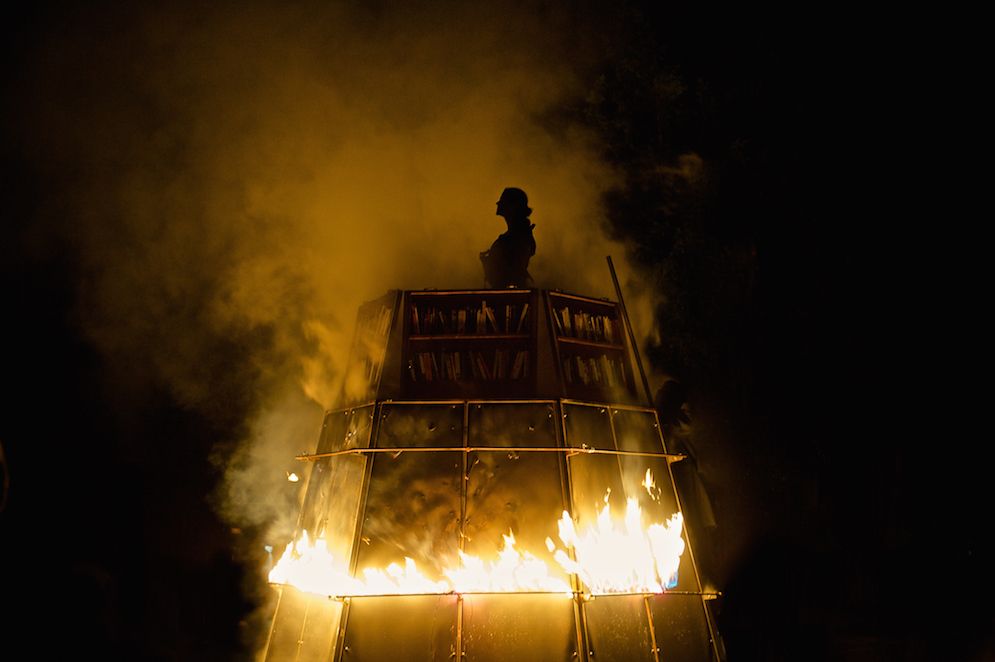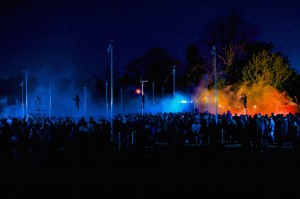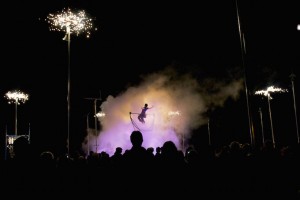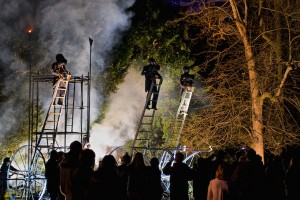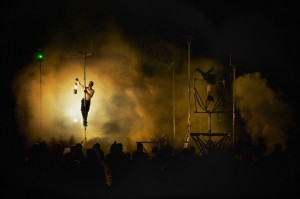It’s 8.30pm on a cool and breezy, but thankfully dry, evening in April. A crowd is gathering in the grounds of Shaw House in Berkshire. The house itself is an Elizabethan mansion, providing a moody backdrop to the cluster of structures standing in the gardens. Furthest away from the house is a grouping of tall metal scaffolds and ladders, bookended by a couple of wheeled segways (ominous looking giant metal tripods). Nearest to the house is a built structure that looks like a small, many-sided wooden house. In between these two stations is a circle of metal fences containing an odd kind of seat fixed on to a pole, like a one-man fairground ride. All around the space are ‘lamposts’ with tannoy speakers topping them – lots of them, making the space an unnerving futuristic forest of dead white trees. From these posts come constant and relentless announcements, in a babel of languages. English, French, Spanish, German – and perhaps others I can’t identify. As we walk around the space we are subjected to a constant bombardment of sound – the endless announcements mixed with the drone of whirring helicopters and jet planes flying low. The lighting is cold and blue, the atmosphere eery.
This is the pre-show setting for Periplum’s 451, the company’s latest large-scale outdoor show, created in collaboration with the Corn Exchange and New Greenham Arts in Newbury – hence this preview show in Berkshire, just down the road from the 101 Creation Centre at Greenham Common, where the show was made and rehearsed. It is inspired by Ray Bradbury’s dystopian near-future novel, Fahrenheit 451, which was published in 1953 (just five years after George Orwell’s 1984). In the novel, firemen are no longer needed to put out house fires, as technology has evolved to make houses fireproof. Instead, they are employed to start fires with kerosene in their hoses in place of water. They are called upon to seek out and destroy the agents of rebellion – those few people left in this disturbed world who are free-thinkers, preferring the now-banned books to the constant wall-to-wall onslaught of drivel dished out to them by an ever-encroaching media. (Yes, it’s prophetic, although like all such dystopias it is as much about the society the writer lives in – in this case consumerist 1950s America – as the future.) Occasionally, a fireman wavers in his resolve and finds himself stealing a book to read rather than burning it. Such a man is Guy Montag. Although most then see the error of their ways, Fireman Montag realises that there is no going back…
The show plays out with the expected flurry of fiery action, as resisters are rounded up and literary masterpieces destroyed – in this world, anything other than an instruction manual is seen as subversive. The bible, fiction, poetry, philosophy – it is all denounced as dangerous nonsense. A particularly beautiful and disturbing recurring motif in the show is the fluttering of book leaves in the night air. There’s plenty of noise and bluster as fire-engines (those three-wheeled segways) roar through the crowd and blazing flame-throwers apparently lay to waste undesirable printed matter and (even more disturbingly) people, including a brave woman who refuses to leave her precious books and thus burns with them.
What I’m pleased to see, though, is that the many quieter moments of the story are given attention, in darker, slower scenes in the show that contrast well with the bombastic burnings. Much of Bradbury’s novel features scenes of Montag walking alone in dark streets, or sitting quietly at home ignoring the constant onslaught of soap operas and government-controlled news broadcasts – desperately seeking peace, and trying to learn how to think for himself. That central ‘seat’ structure becomes Montag’s literal and metaphorical home, and the way it is used portrays the journey he takes: from frozen resistance, to disturbed confusion, to active rejection of the system. The inner voice – and the power of words (thought, written, spoken) over relentless screen images – is a crucial element of Fahrenheit 451, and that is reflected in this production.
This is the first show of a major outdoor work using a very complex array of technical equipment, featuring demanding physical performance on and off the equipment, live and recorded music and text, an inventive lighting and sound design, and pyrotechnics of all sorts, and the cast have had only limited time to work with this complexity of structures and forms – so there is inevitably something of a tentative feel about some scenes. But this of course will change as the show tours, and it is necessary to see it as what it is – a preview of a piece of work that is still evolving. It is worth acknowledging here that major large-scale outdoor shows of this sort can’t actually be fully realised until show time – partly because of the cost of pyrotechnic and other materials, and partly because the way that the audience moves in the space and responds to the cast and equipment helps determines the pace and rhythm of the show. The previous night had seen a technical ‘dress rehearsal’ in front of an invited audience – tonight is the first public outing. And although there is work still to be done, what we see presented here is a fantastic achievement – a rich mix of spectacular visual imagery, stunning sound installation, and thought-provoking storytelling.
So what has been the process bringing us to this point?
451 is an idea that has been incubating for quite a while. Periplum’s co-directors Claire Raftery and Damian Wright tell me that producer Simon Chatterton first approached them with the idea in 2009, as it had long been an idea of his that an outdoor version of Bradbury’s novel would be an interesting project. They agreed that the book had elements that would make a good visual outdoor show, and enough prophetic content about modern-day living to interest them.
The company have built their reputation by presenting a broad variety of work within the context of ‘outdoor arts’ (essentially, work presented free to audience in a public space). As with previous large-scale shows Arquiem and The Bell, in developing 451 Periplum have resisted the notion that work presented outdoors has to be mere entertainment.
‘We firmly believe that audiences do not need to be spoon-fed easy narratives all of the time, and that a rich variation of content and artforms can easily be presented outdoors’ says Claire. ‘Restrictions to content on the assumption that simple narrative is the only thing that works, or is allowed to work, means that artists are restricted to basing works solely on simplistic subject matter. Restrictions like these do not allow the huge variation in content that you normally see across the indoor arts. If we are free to take chances and to stretch the boundaries, audiences may indeed like to be challenged a bit more.’
For this new show, the company worked in a new way, in collaboration with Corn Exchange: ‘We used the book as a starting point to create a visual storyboard for the outdoor show. We don’t usually work with storyboards, as we usually create from multi-sensory worlds, where sound and atmosphere work at the same time as the visual element.’ In this case, storyboarded ideas were then shared with their production collaborators, who took on responsibilities that Periplum usually manage internally themselves.
I ask Claire and Damian about the creation of the structures that are such an intrinsic part of the work, and learn that some of the set is adapted from previous Periplum shows (made by Mike Pattison), and some designed by Martin West, resident maker at 101. ‘The first image I brought to Martin was of the North Korean Police on segways’ says Claire.’The image showed man and machine merging – I was interested in how this would have looked to someone 50 years ago. The idea came to use old-style and modern together – so Martin designed and made three giant segway fire engines.’ Apparently these were originally motorised and operated by one person, but during the development stage they removed the motorisation. Which is probably all for the good as they are quite frightening enough hurtling through the space without motors!
Another feature of the set is the aerial ‘manlift’ in the central circle, which is mostly Montag’s terrain. ‘I originally drew a chair which raised up into the air on a long pole (mirroring the fire-fighters’ poles) – to show the isolation of each person in their home’ says Claire. ‘When the central character (renegade fireman Montag) reads for the first time, he would physically spin in mid-air to show the effect the words were having on him.’
After a long and troubled search, they found the ideal man-lift sitting in a Lewes makers’ workshop and this is now hired from another company. The chair feature was made by Tarn Aitken who works with No Fit State.
The climbing poles are a Periplum obsession, and have been used in their work in different forms for many years now. ‘We drew out a city landscape of poles, drawn from the electricity pylons they have across the river there’ says Claire. ‘Originally the idea was to have performers trapped on the wires between, but we have never had access to the kind of budget that would allow that! We have for many years wanted to use a series of poles for performers to create an immersive city landscape. 451 came along and the idea fit the narrative. The watchtower or fire station is designed by Mike Pattison for another Periplum show, and for this we added 2 firemen’s poles to slide down. We couldn’t resist that!’
Claire then goes on to discuss the Tannoy system used in the show: ‘We have been pushing experimentation with multi-sound systems and split harmonics for a few years and the Tannoy design in 451 is an extension of this – they’re spread out amongst the audience, another way of creating an immersive space in the challenging outdoors, and a risk for us to attempt a merger of sound installation with large-scale narrative work. These were made by Graeme Calvert.’
I’m interested to know how Damian’s process as writer has been on this show – the first time they’ve had a novel as a starting point (although in other work, texts in other forms, such as poems and song lyrics, have been an inspiration).
Damian says: ‘As with most of our work, in 451 there’s a lot of cross-over between Claire and myself in the writing and direction roles. Claire is very good at giving a motif or a concept for a speech. I come into a rehearsal process with lots of material, and this gets adapted, dropped, added to as the piece comes into reality. The main challenge and joy with exploring 451 was to make it resonate for people today, and there’s so much in the book that’s predictive of our modern, interactive world – as individuals and as a social collective we’ve chosen this digital hall of mirrors while other forces cook up chaos and strange order, adding to the confusion of our over-stimulated lives. By writing for outdoor arts, we’re trying to relate to the audience directly and in the moment; to bring them into this reality, but also to provoke questions about realities in their own lives.’
Claire corroborates this view of the writing/directing/designing process as intertwined: ‘Periplum itself is a series of collaborations, starting with Damian and myself collaborating at the heart of the company’ she says. ‘We create with individual makers, designers, composers, musicians, performers, and the pyrotechnic company Lightfires. We were grateful to be able to continue these trusted collaborations into the making of 451, and to make a few new ones.’
Although the showing in Berkshire is the culmination of one stage of this precious collaboration, in another way it is the start of the next phase. The elements are in place – now comes the bedding in. I’m excited to have witnessed this crucial moment in the development of the show. It’s an honour to be at any birth – and the birth of a major new outdoor arts show by Periplum is a fantastic addition to the world.
All photos are by Ray Gibson.
Footnotes:
Periplum’s 451 is co-produced by Corn Exchange Newbury and New Greenham Arts.
It is funded by Arts Council England, and built at 101 Outdoor Arts Creation Space. The show was commissioned by Without Walls Street Arts Consortium, Brighton Festival, Greenwich & Docklands Festival, and Norfolk & Norwich Festival.
451 will appear at:
Brighton Festival, Preston Barracks, 16 May 2015
Norfolk & Norwich Festival, 22 May 2015
Greenwich & Docklands International Festival, 27 June 2015
Stockton International Riverside Festival, 31 July 2015
Credits:
Design, adaptation, script and direction –Periplum (Claire Raftery & Damian Wright)
Music Composition – Mike Simmonds & Barry Han
Pyrotechnics by Lightfires
Set design engineering – Martin West, Mike Pattison, Tarn Aitken
Sound design – Aidan O Brien
Tannoy design – Graham Calvert
Performed by:
Danielle Corbishley
Milo Foster-Prior
Steven Grainger
Florencia Leon
Ben Phillips
Mike Simmonds
Ali Sparror
Will Strange
Voiceover: Aurelian Koch

